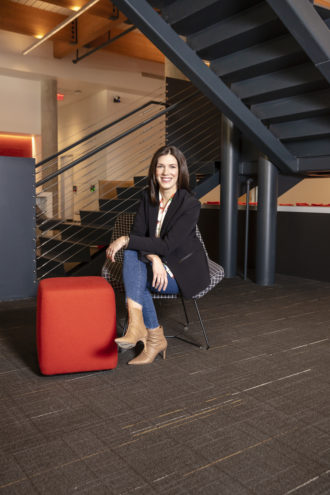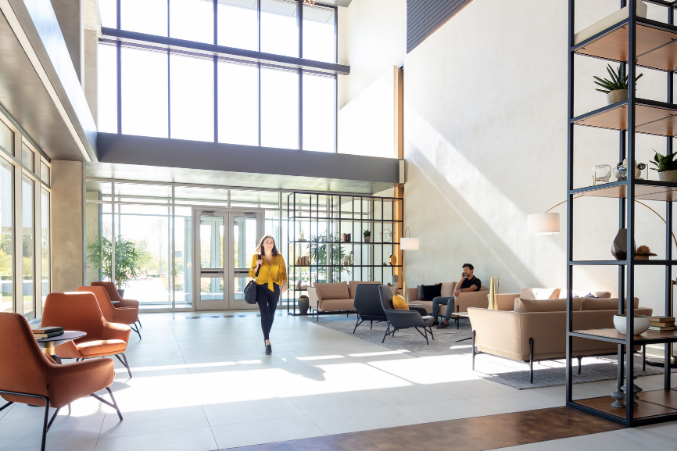“Well, where are you going?” I asked my husband a couple of weeks ago as he rounded the corner in a suit. My visceral reaction got me thinking about how the pandemic has changed how we think about what we wear to work—not just where we work.
As a designer, I understand the importance of aligning an organization’s culture, values, and policies with the aesthetic of the space. Lawyers, developers, and bankers in their formal business attire look appropriate in their wood and stone workplaces. Tech firms with concrete flooring and coffee bars are a better fit for the t-shirts and sneakers vibe. It makes sense. But now, whether you have been going to your office or not, I can safely say—we aren’t dressing the same.

We aren’t dressing up. In a predominately virtual world, we are dressing for ourselves. We talk about the pandemic being an accelerator of remote work and collaborative technology. It may also accelerate heels and ties right out of our work attire forever.
The evolution of the suit and business attire, like all fashion, has followed a trend pattern that mirrors major economic and cultural shifts in our country—a reflection of our values, lifestyles, and sentiment. For example, in the 1920s, embellishment dominated preferences as tie pins gained popularity and shirts became more colorful.
Conversely, the 1930s saw a more somber economy and a palette. Power suits reigned in the 80s while tailoring took center stage in the 2000s. Enter a start-up tech culture that rejected the traditional office dress code—donning denim as a badge of honor and most recently, normalizing business casual. Working from home for the bulk of 2020, the majority of American employees have categorically, at least from the waist down, adopted a much more comfortable dress code.
Let’s be honest, suits and ties were already on the endangered species list. Mostly making their daytime appearances at law firms, real estate companies, and banks.
Granted, it will be hard to spot the lawyers if they start wearing jeans. I have seen some very prominent Dallas developers looking sharp in golf shirts and Allbirds in recent months. Barney Stinson may have invoked “Suit Up!” for almost every occasion, but that’s just not happening anymore. Let’s lean into this opportunity to reflect our personal brand and align our dress to the tasks of the day.
Next on the chopping block, and far more personally and selfishly motivated: high heels in the office. This notoriously painful style is much more appropriate for shorter, after-hour functions as opposed to laps around the office. As the focus on workplace equality has sharpened, the notion that women should feel required to outwardly express themselves in a prescribed way is over. If my fashion sneakers cost more than my high heels, doesn’t that really tell you all you need to know? A personal brand is a big deal—especially if you work in design. Fashion serves as a language to tell stories about what we are about, what we value, and how we see the world.
I can’t help myself. This does tie back to the workplace.

In organizations with the most sustainable cultures, policies, and place are aligned. Think about it. A more casual, brighter, welcoming, and fun office design accompanied the adoption of less serious dress codes. And, as expanded flexibility and mobility rose in popularity because of new technologies, the office also became more comfortable with a mix of lounge-inspired break out spaces. So, if we want to prioritize wellness with sit-to-stand desks and encourage employees to use the stairs versus the elevator, can we just decide that the ultra-high heel need not return to the office?
Speaking of the office, it isn’t going anywhere; rather, the workplace, like fashion, has always responded to culture and lifestyle changes.
As businesses and employees make it work—changing directions quickly through uncertainty to compete and deliver for clients—comfort, functionality, and agility have come front and center in shaping not only the ways we dress but also the spaces we work. From personal wardrobes and communication platforms to when and where we work, we’ve established a consensus that places a premium on removing friction points as the pandemic underscores a heightened value on seamlessness, flexibility, and fluidity.
Just as remote work welcomed new personal technologies and the demand for workplace wellness ushered in seas of sit to stand desks, the shift in our post-pandemic preferences and expectations has not only revealed what we need from a more supportive, nimble workplace but also why while we may call it quits on ties and heels, we can’t call it quits on the office. Seems like dressing in the uniforms of the past works counter to digging into what’s possible. If I need to move fast and change directions quickly, I’m wearing flats.
Ties and heels, thank you for your service to the workplace, I look forward to seeing you at galas, weddings, and fundraisers in the near future where you can be most appreciated and photographed.
Lindsay Wilson is the president of Corgan.





